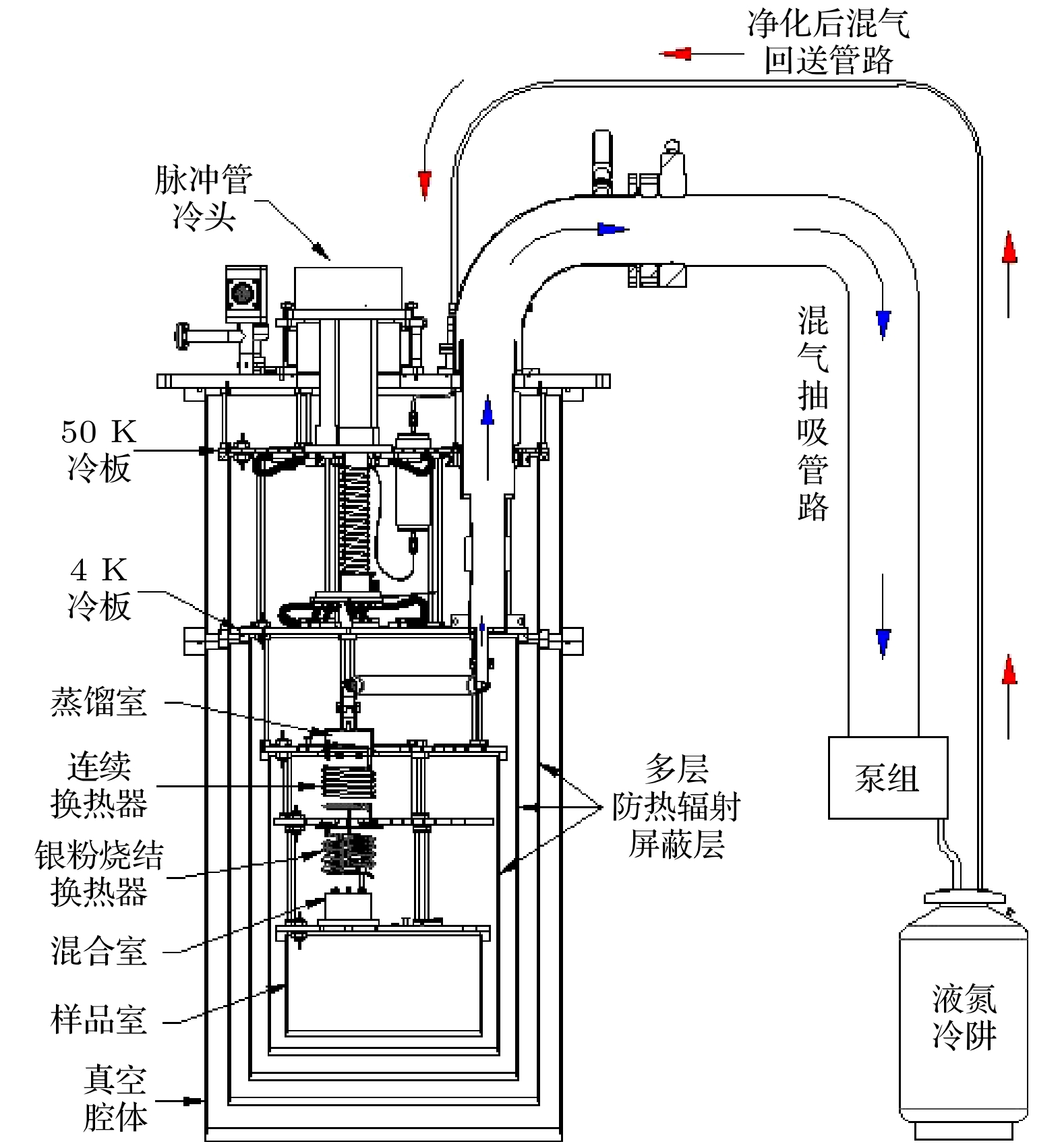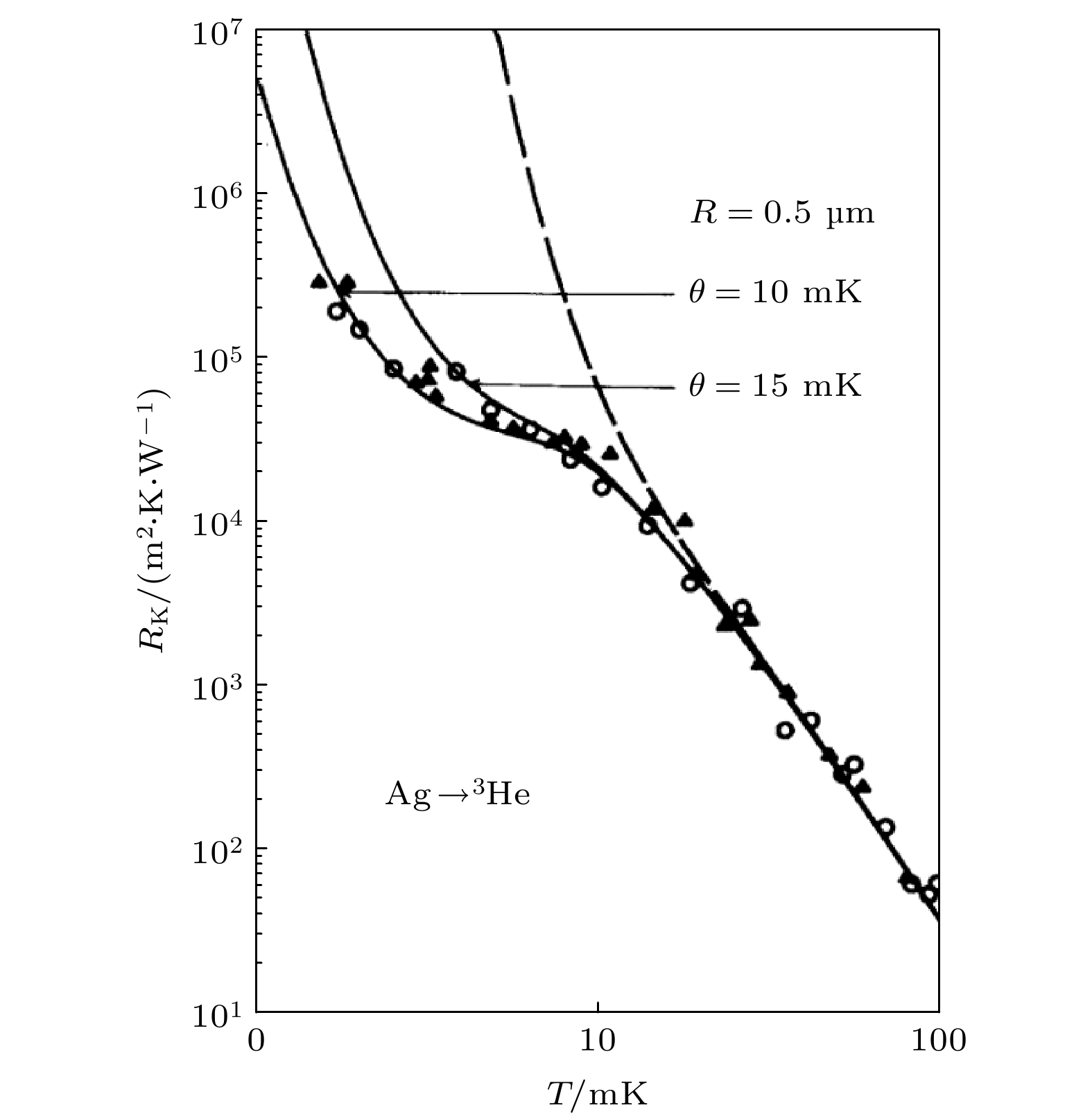-
In the research of cryogenic physics and quantum information science, it is essential to maintain a steady low temperature of millikelvin regime continuously. Dilution refrigerator is a widely used refrigeration device to achieve extremely low temperature. It utilizes the phase separation effect of superfluid 4He and its isotope 3He mixed solution at ultra-low temperatures. The performance of heat exchanger is the key factor to determine the performance of continuous cycle refrigerating machine. At extremely low temperatures, there appears a huge interfacial thermal resistance between helium and metal (Kapitza resistance), and the problem of heat exchange can be effectively solved by using the porous sintered metal particles to increase the contact area. Therefore, it is of significance to study the heat exchange between metal particles and liquid helium at extremely low temperature and to develop the relevant high-performance sintered Ag powder heat exchanger.
[1] London H 1951 Proc. Int. Conf. on Low Temperature Physics Oxford, UK, August 22–28, 1951 p157
[2] Cao H 2021 J. Low Temp. Phys. 204 175
 Google Scholar
Google Scholar
[3] 阎守胜 1975 物理 2 111
Yan S S 1975 Physics 2 111
[4] Wheatley J C 1968 Am. J. Phys. 36 181
 Google Scholar
Google Scholar
[5] 郑茂文, 卫铃佼, 全加, 林鹏, 梁惊涛, 赵密广 2020 低温物理学报 4 211
Zheng M W, Wei L J, Quan J, Lin P, Liang J T, Zhao M G 2020 Low Temp. Phys. Lett. 4 211
[6] Deng C, Huang Y, An M, Yang N 2021 Mater. Today Phys. 16 100305
 Google Scholar
Google Scholar
[7] Deng S, Xiao C, Yuan J, Ma D, Li J, Yang N, He H 2019 Appl. Phys. Lett. 115 101603
 Google Scholar
Google Scholar
[8] Xu D, Hanus R, Xiao Y, Wang S, Snyder G J, Hao Q 2018 Mater. Today Phys. 6 53
 Google Scholar
Google Scholar
[9] Wang S, Xu D, Gurunathan R, Snyder G J, Hao Q 2020 J. Materiomics 6 248
 Google Scholar
Google Scholar
[10] Huang Y, Feng W, Yu X, Deng C, Yang N 2020 Chin. Phys. B 29 126303
 Google Scholar
Google Scholar
[11] Xu Y, Wang X, Hao Q 2021 Compos. Commun. 24 100617
 Google Scholar
Google Scholar
[12] Swartz E T, Pohl R O 1989 Rev. Mod. Phys. 61 605
 Google Scholar
Google Scholar
[13] Frossati G, Godfrin H, Hebral B, Schumacher G, Thoulouze D 1978 Proceedings of the Ultralow Temperatures Symposium (Tokyo: Physical Society of Japan)
[14] 曹烈兆, 阎守胜, 陈兆甲 1999 低温物理学 (合肥: 中国科学技大学出版社) 第89页
Cao L Z, Yan S S, Chen Z J 1999 Cryogenics (Hefei: Press of University of Science and Technology of China) p89 (in Chinese)
[15] Nakayama T 1989 Prog. Low Temp. Phys. 12 115
[16] Nishiguchi N, Nakayama T 1983 Solid State Commun. 45 877
 Google Scholar
Google Scholar
[17] Osheroff D D, Richard R C 1983 Phys. Rev. Lett. 54 1178
[18] Hu Y, Stecher G J, Gramila T J, Richard R C 1996 Phys. Rev. B 54 R9639
 Google Scholar
Google Scholar
-
图 3 超低温稀释制冷机系统及其关键换热部件: 连续换热器和银粉烧结换热器(图片由南方科技大学量子科学与工程研究院提供)
Fig. 3. Ultra-low temperature dilution refrigerator system and its key components: Continuous heat exchanger and sintered Ag powder heat exchanger. (Image courtesy of Institute for Quantum Science and Engineering, Southern University of Science and Technology).
图 4 金属纳米颗粒与3He液体之间的界面热阻. 圆点为实验值, 虚线为单金属颗粒计算值, 实线为考虑烧结颗粒中软声子模式后的计算值, 摘自文献[16]
Fig. 4. Interfacial thermal resistance between metal nanoparticles and liquid 3He. The dot is the experimental value, the dashed line is the calculated value of single metal particles, and the solid line is the calculated value after considering the soft phonon mode in the sintered particles, which is extracted from the Ref. [16].
-
[1] London H 1951 Proc. Int. Conf. on Low Temperature Physics Oxford, UK, August 22–28, 1951 p157
[2] Cao H 2021 J. Low Temp. Phys. 204 175
 Google Scholar
Google Scholar
[3] 阎守胜 1975 物理 2 111
Yan S S 1975 Physics 2 111
[4] Wheatley J C 1968 Am. J. Phys. 36 181
 Google Scholar
Google Scholar
[5] 郑茂文, 卫铃佼, 全加, 林鹏, 梁惊涛, 赵密广 2020 低温物理学报 4 211
Zheng M W, Wei L J, Quan J, Lin P, Liang J T, Zhao M G 2020 Low Temp. Phys. Lett. 4 211
[6] Deng C, Huang Y, An M, Yang N 2021 Mater. Today Phys. 16 100305
 Google Scholar
Google Scholar
[7] Deng S, Xiao C, Yuan J, Ma D, Li J, Yang N, He H 2019 Appl. Phys. Lett. 115 101603
 Google Scholar
Google Scholar
[8] Xu D, Hanus R, Xiao Y, Wang S, Snyder G J, Hao Q 2018 Mater. Today Phys. 6 53
 Google Scholar
Google Scholar
[9] Wang S, Xu D, Gurunathan R, Snyder G J, Hao Q 2020 J. Materiomics 6 248
 Google Scholar
Google Scholar
[10] Huang Y, Feng W, Yu X, Deng C, Yang N 2020 Chin. Phys. B 29 126303
 Google Scholar
Google Scholar
[11] Xu Y, Wang X, Hao Q 2021 Compos. Commun. 24 100617
 Google Scholar
Google Scholar
[12] Swartz E T, Pohl R O 1989 Rev. Mod. Phys. 61 605
 Google Scholar
Google Scholar
[13] Frossati G, Godfrin H, Hebral B, Schumacher G, Thoulouze D 1978 Proceedings of the Ultralow Temperatures Symposium (Tokyo: Physical Society of Japan)
[14] 曹烈兆, 阎守胜, 陈兆甲 1999 低温物理学 (合肥: 中国科学技大学出版社) 第89页
Cao L Z, Yan S S, Chen Z J 1999 Cryogenics (Hefei: Press of University of Science and Technology of China) p89 (in Chinese)
[15] Nakayama T 1989 Prog. Low Temp. Phys. 12 115
[16] Nishiguchi N, Nakayama T 1983 Solid State Commun. 45 877
 Google Scholar
Google Scholar
[17] Osheroff D D, Richard R C 1983 Phys. Rev. Lett. 54 1178
[18] Hu Y, Stecher G J, Gramila T J, Richard R C 1996 Phys. Rev. B 54 R9639
 Google Scholar
Google Scholar
计量
- 文章访问数: 16057
- PDF下载量: 462
- 被引次数: 0














 下载:
下载:



